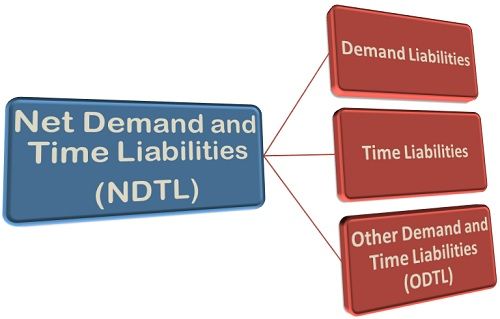Definition: The Net Demand and Time Liabilities or NDTL shows the difference between the sum of demand and time liabilities (deposits) of a bank (with the public or the other bank) and the deposits in the form of assets held by the other bank.
In other words, the net demand and time liabilities of a bank can be calculated by using the following formula:
Bank’s NDTL = Demand and time liabilities (deposits) – deposits with other banks
Suppose a bank has deposited 5000 with the other bank and its total demand and time liabilities (including the other bank deposit) is 10,000. Then the net demand and time liabilities will be 5,000 (10,000-5,000).
Thus, the deposits of a bank are its liabilities that can be in the form of demand liability, time liability and other demand and time liabilities. Let’s discuss these in detail:
Demand Liabilities: The demand liabilities include all those liabilities of a bank which are payable on demand. Such as current deposits, cash certificates and cumulative/recurring deposits, outstanding telegraphic transfers, Demand drafts, margins against the letter of credit/guarantees, credit balance in cash credit account, etc., all are paid on demand.
Time Liabilities: Time liabilities are those liabilities of a bank which are payable otherwise on demand. These include fixed deposits, cash certificates, staff security deposits, time liabilities portion of saving deposits account, margin held against the letter of credit (if not payable on demand), gold deposits, etc.
Other Demand and Time Liabilities: These include all those miscellaneous liabilities which are not covered in above two types of liabilities. Such as interest accrued on deposits, unpaid dividend, suspense account balances showing the amount due to other banks or public, participation certificates issued to other banks, cash collaterals, etc.


Nagaraju says
Thanks business jargons
Prakash Tandel says
Thanks Business Jargons
Shubham Mishra says
Thanku so Much
subrahmanyam says
Dear businessjargoans,
Please explain why banks request their customers to maintain balance on every quarter or half yearly or annually in their accounts.
some banks they will term it as CASA target.
please explain what is the use of it.
Kirti says
sir, I have a question, why we subtract the assets with other banks, why not subtract all assets, like when bank grant loans to their customers that are also assets and come towards bank again, so why we don’t?
please help me to clear this concept.
Shyam Sureliya says
Nice Explanaiton
Jashim says
Thanks for helping !
Such explanations are crystal clear.